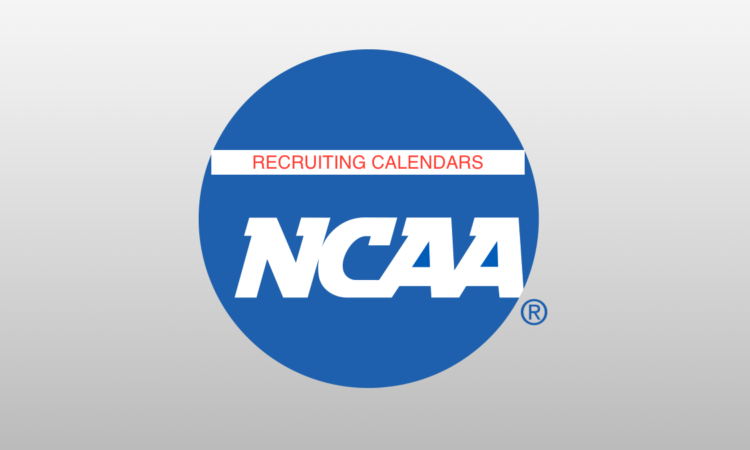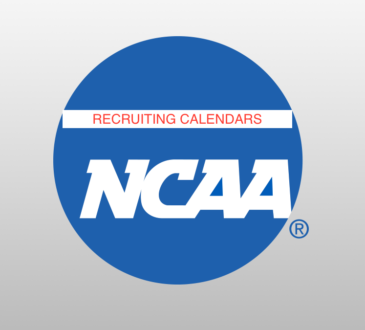
The NCAA Recruiting Calendars outline when—and how—NCAA DI and DII college coaches can proactively start recruiting athletes. With the recruiting process starting earlier and earlier, however, the dates don’t represent when recruiting really starts for student-athletes. In fact, most athletes start their recruiting process well before the dates outlined on the calendar. As early as eighth grade, families are researching colleges, evaluating what division level is best for their athlete, ensuring they are on the path to NCAA eligibility and even proactively reaching out to college coaches.
However, it’s still important to know the different periods in the NCAA Recruiting Calendar to understand how you should be getting recruited at that point during the year, as well as the kind of communication you can expect to receive from a coach. For example, if it’s October of your junior year in high school and you haven’t heard from a single coach, you have some work to do. If it’s October of your sophomore year of high school, you shouldn’t expect to hear from coaches, but you probably should be making progress on your recruiting journey.
Overall, the NCAA Recruiting Calendars seek to protect elite athletes from receiving overwhelming amounts of communication from college coaches by designating certain time periods when coaches cannot contact athletes. The NCAA explains, “Recruiting calendars help promote the well-being of prospective student- athletes and coaches and ensure competitive equity by defining certain time periods in which recruiting may or may not occur in a particular sport.”
How to use the NCAA Recruiting Calendars
Use the recruiting calendar alongside the NCAA Recruiting Rules. The NCAA Recruiting Rules mandate the types of communication athletes can receive from college coaches based on the athlete’s year in high school. The NCAA Recruiting Calendars show the specific recruiting time periods throughout the year when coaches can contact athletes—and when coaches aren’t allowed to contact athletes.
Generally speaking, the most important dates on the calendar will be June 15 or September 1 (depending on your sport), going into the athlete’s junior year of high school. For most sports, this is when coaches can start reaching out to recruits. For more specific dates, find your sport-specific calendar below.
RECRUITING CALENDARS
Key terms in the NCAA Recruiting Calendars
To better understand the NCAA Recruiting Calendars, it’s important to familiarize yourself with the following terms:
- What is a Contact? A contact occurs any time a college coach says more than hello during a face- to-face contact with a college-bound student-athlete or his or her parents off the college’s campus.
- What is a Contact Period? During a contact period a college coach may have face-to-face contact with college-bound student-athletes or their parents, watch student-athletes compete and visit their high schools, and write or telephone student-athletes or their parents.
- What is an Evaluation Period? During an evaluation period a college coach may watch college-bound student-athletes compete, visit their high schools, and write or telephone student-athletes or their parents. However, a college coach may not have face-to-face contact with college-bound student-athletes or their parents off the college’s campus during an evaluation period.
- What is a quiet period? During a quiet period, a college coach may only have face-to-face contact with college-bound student-athletes or their parents on the college’s campus. A coach may not watch student- athletes compete (unless a competition occurs on the college’s campus) or visit their high schools. Coaches may write or telephone college-bound student-athletes or their parents during this time.
- What is a dead period? During a dead period a college coach may not have face-to-face contact with college-bound student-athletes or their parents, and may not watch student-athletes compete or visit their high schools. Coaches may write and telephone student-athletes or their parents during a dead period.
- What is the difference between an official visit and an unofficial visit? Any visit to a college campus by a college-bound student-athlete or his or her parents paid for by the college is an official visit. Visits paid for by college-bound student-athletes or their parents are unofficial visits.
During an official visit the college can pay for transportation to and from the college for the prospect, lodging and three meals per day for both the prospect and the parent or guardian, as well as reasonable entertainment expenses including three tickets to a home sports event.
The only expenses a college-bound student-athlete may receive from a college during an unofficial visit are three tickets to a home sports event. As you look through the NCAA Recruiting Calendar for your sport, keep an eye out for some of the particular days that stand out within each period. For example, you may have a quiet period from September 1 through November 25, but within that time span, there will be a designated number of evaluation days in which coaches can assess either your athletic or academic qualifications in person.
AllStarRecruits attempts to provide you with the latest up to date information.
Always be sure to check the NCAA Recruiting Calendar dates here.
RECRUITING CALENDARS
Jump to your Sport:
- Division I Bowl Sub-Division Football Recruiting Calendar
- Division I Championship Sub-Division Recruiting Calendar
- Division I Baseball Recruiting Calendar
- Division I Men’s Basketball Recruiting Calendar
- Division I Women’s Basketball Recruiting Calendar
- Division I Cross Country and Track & Field Recruiting Calendar
- Division I Men’s Golf Recruiting Calendar
- Division I Men’s Lacrosse Recruiting Calendar
- Division I Women’s Lacrosse Recruiting Calendar
- Division I Women’s Volleyball Recruiting Calendar
- Division I Women’s Beach Volleyball Recruiting Calendar
- Division I Softball Recruiting Calendar
- Division I All Other Sports Recruiting Calendar
- Division II Football Recruiting Calendar
- Division II Men’s Basketball Recruiting Calendar
- Division II Women’s Basketball Recruiting Calendar
- Division II All Other Sports Recruiting Calendar
RECRUITING CALENDARS
What is the NCAA Guide for the College Bound Student Athlete?
The NCAA Guide for the College Bound Student Athlete is a booklet of information distributed each year by the NCAA to help student-athletes, families, high school coaches and administrators understand the initial eligibility process for Division I and Division II schools. The guide provides resources, such as:
- An initial eligibility checklist
- Time management expectations for Division I athletes
- How to register for a Certification Account – and who needs one
- Division I and Division II academic standards
- Division III academic information
- Division I and Division II initial eligibility worksheets
- Required courses and test scores
- An explanation of recruiting rules specifically for home school students and international students
- Important terms
- Recruiting calendars
- Scholarship opportunities
- Useful information about the National Letter of Intent
We recommend reviewing this information with your family and guidance counselor to ensure that you are checking off all the boxes to be academically eligible to compete in your sport at the next level. The 2018- 2019 Guide for the College Bound Student Athlete contains the eligibility information for both Division I and Division II schools.






